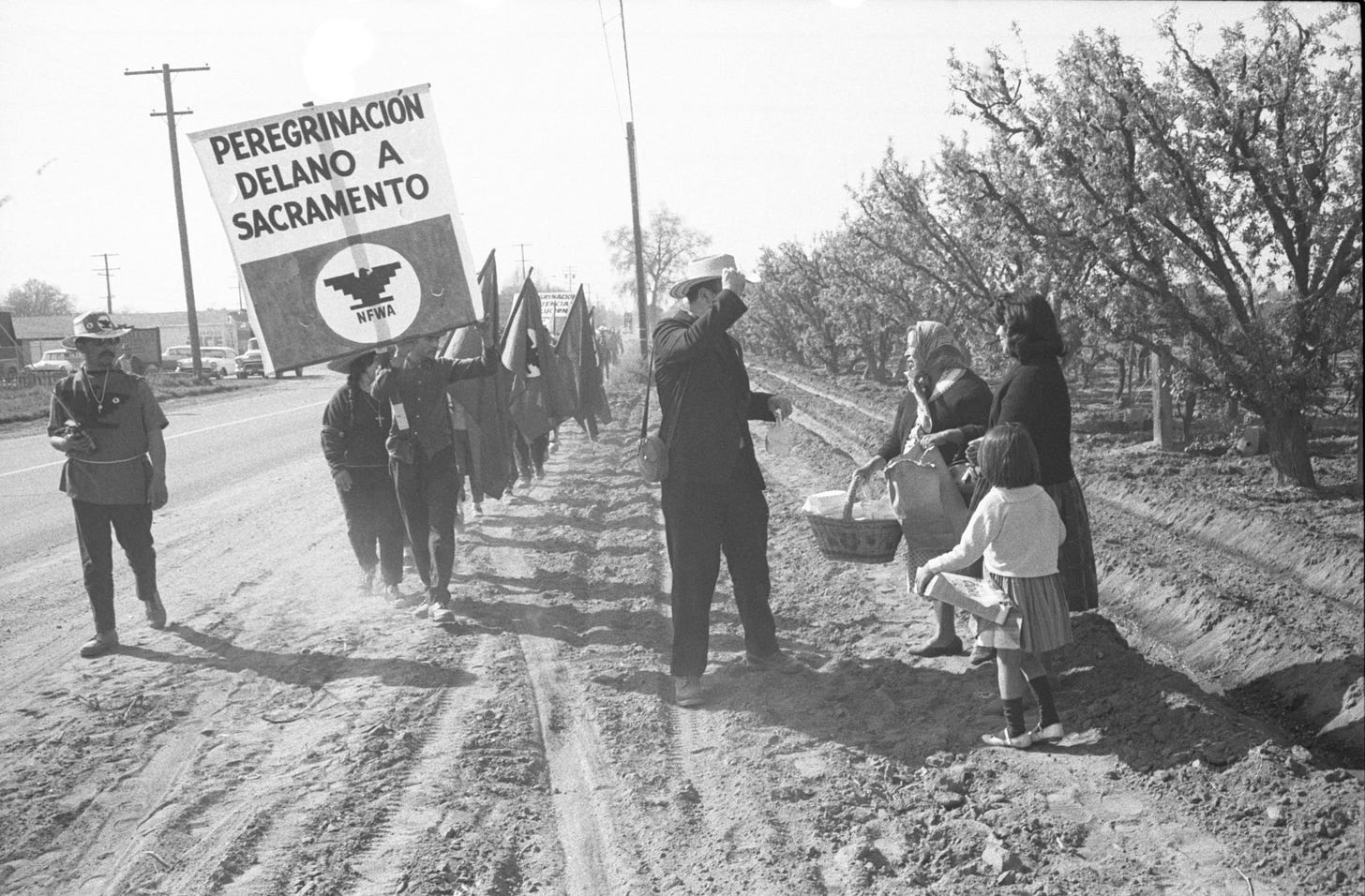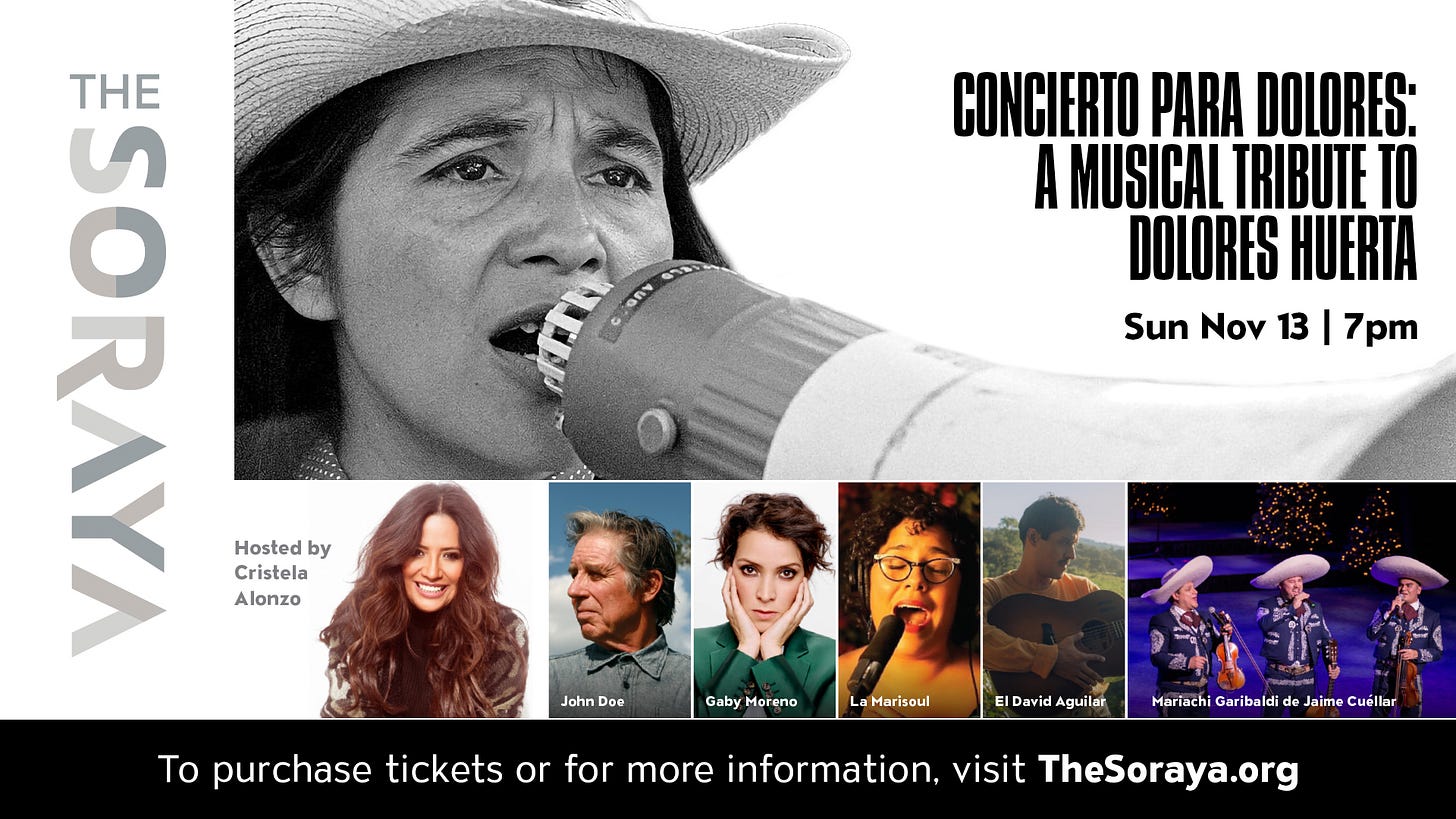Last week, California Gov. Gavin Newsom signed the Agriculture Labor Relations Voting Choice Act (AB 2183) after farmworkers marched to Sacramento. In this newsletter, we trace back the history of pilgrimages to 1966 when the farmworkers marched from Delano to Sacramento for the first time—a march documented by photographer John Kouns. We also reiterate our invitation to come on Nov. 13, to our performing arts center, The Soraya, for the Concierto Para Dolores: A Musical Tribute to Dolores Huerta. Also, you can watch a video of Huerta’s keynote speech at CSUN back in 1995 and a preview of the images we are preparing for the exhibition Hope and Dignity for Farmworkers in The Soraya’s Art Gallery which will open on the same day.
Following Tradition
On August 3rd, 2022, in the middle of the summer’s worst temperatures, the UFW and allies started their 24-day pilgrimage from Delano to Sacramento and called it the “March for the Governor’s Signature.” The march traced the historic 300-mile route taken during the 1966 march to Sacramento, this time to urge Gov. Gavin Newsom to sign AB 2183, a bill that grants farmworkers new ways to vote in union elections beyond physical polling places on farm property. On Sept. 28th, the farmworkers’ dedication and sacrifice paid off when Gov. Newsom signed the bill. Their victories echoed those of the 1966 pilgrimage to Sacramento when the National Farmworker Association (NFWA) and the Agricultural Workers Organizing Committee (AWOC) would set in motion a tradition for farmworkers to use the march as a powerful tactic to spotlight the fight for economic and social justice and bring the “farm workers’ grievances before the nation’s conscience.”

The first 25-day pilgrimage from Delano to Sacramento in 1966 started on March 17th and ended on Easter Sunday, April 10th, when César Chávez and many others stood before a crowd of over 10,000 to demand their right to strike, as well as their civil rights. Just four days prior to their arrival at the State Capitol, Chávez secured an agreement with Schenley where the NFWA was recognized as the bargaining agent for their farmworkers, allowing for contract negotiations to take place which were the first steps to demand living wages and job security. The 1966 pilgrimage is a symbol of power for the farmworkers. While not all marches throughout the course of the UFW history were successful in securing tangible victories, the farmworkers never broke away from tradition.

Referring to the march as a pilgrimage was intentional; the farmworker organizers associated the word with penance and revolution. César Chávez wrote in March of 1966, in preparation for the march to Sacramento, “The pilgrimage from Delano to Sacramento has strong religio-cultural overtones. But it is also the pilgrimage of a cultural minority who have suffered from a hostile environment, and a minority who means business.”


Dolores Huerta is coming to CSUN on Nov. 13
By José Luis Benavides
On Sunday, Nov. 13, CSUN’s performing arts center, The Soraya, will host Concierto Para Dolores: A Musical Tribute to Dolores Huerta. The concert will honor Huerta’s lifetime devotion to the labor and civil rights movements and includes world-class performers like Cristela Alonzo, Gaby Moreno, La Marisoul, John Doe, El David Aguilar, and Mariachi Garibaldi de Jaime Cuéllar in this celebration directed by Dan Guerrero, and Musical Director Cheche Alara. Get your tickets soon!
And thanks to the work of our archivist Keith Rice in digitizing our old video cassettes of the Farmworker Movement Collection and the great editing skills of our student worker, Brandon Lien, we can offer you a speech Dolores Huerta delivered at CSUN in 1995. The keynote speech was part of the California Farm Workers Oral History Project, sponsored by the CSUN Provost's Committee on Chicano/Labor History, the School of Humanities, the Urban Archives, and the Center for Photojournalism and Visual History (now the Tom & Ethel Bradley Center). Music and editing by Brandon Lien. Thumbnail photo by Emmon Clarke © Tom and Ethel Bradley Center.
The Bradley Center is also working on the photo exhibition Hope and Dignity for Farmworkers in The Soraya’s Art Gallery which will open to the public the on same day. The exhibition attempts to capture the duality of the struggle faced by farmworkers: hope for a better economic future for themselves and their families by creating a strong union, and dignity in their quest for being recognized as human beings and citizens. The exhibition focuses on the early years of the farmworkers’ struggle, marked by the grape strike, the boycott, the first march/pilgrimage from Delano to Sacramento, the early efforts to organize workers in Texas, and César Chávez’s fasting calling for nonviolence and sacrifice. We offer you here a preview of the images by photographers Emmon Clarke and John Kouns that will be on display at the gallery. When you come to the concert, visit the gallery inside The Soraya to see these images.






